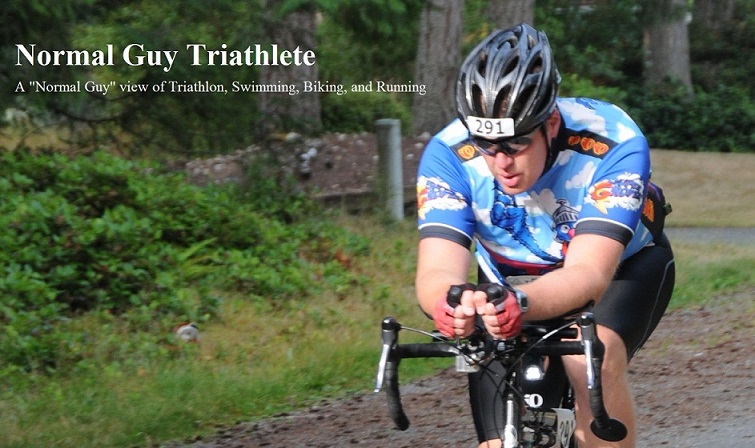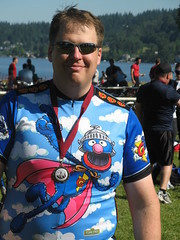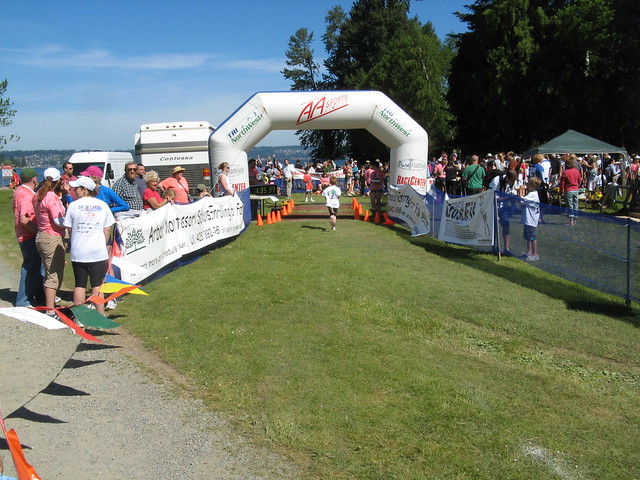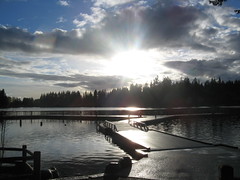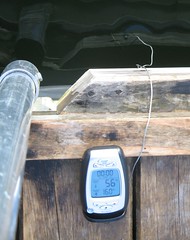Note: In 2013 posted an updated version of this article.
Disclaimer: This post contains referral affiliate links. No other paid compensation or sponsorship.
Triathlons are not for the faint of heart and, apparently, not for the thin of wallet.
"So Triathlon is the new golf?" I was so flabbergasted that I didn't quite no what to say. This could not possibly be true but there was the data in black and white-
"According to a study initiated by USA Triathlon, the average triathlete is a married 38-year-old with an income of $126,000. Forty-four percent have kids living at home; 60% are male. They spend in excess of $4,000 annually on bike gear, athletic footwear, race fees and nutritional supplements. Nearly half have traveled more than 500 miles for a race."
-Natalie Zmuda, Advertising Age
$4000 a year on gear, race fees, and food? PER YEAR? Seriously? If it doesn't turn out to be a fad then there is significant money to be made marketing/selling gear to triathletes in the coming years.
...Unless that triatlete is me. I may be squarely in the demographic quoted above but I spend NO WHERE NEAR that amount of money on my craft. Is it possible to be a triathlete and do it on a shoe-string budget? ABSOLUTELY!
Let's break it down into the main categories mentioned in the article above and see how you can do it without breaking the bank. To be fair to all you lady triathletes out there I called upon an old friend, Valerie, who finished her rookie race this past year and did it for just-over $200!
Finding the Best Deals
TIMING IS EVERYTHING: Best advice I can give you - plan what you need NOW and start researching and window shopping. Notice I didn't say buying? That comes later. If you wait until the last minute to find what you need you will either spend WAY too much (i.e. list price) or find yourself loaded down with worthless gear that doesn't fit or meet your needs.
Once you know what you are looking for, you can take your time and wait for the right sale.
The best time of year to buy gear is the last month of the season and the 2 months following (August-October in North America). That's when shops are clearing out the current year's merchandise, prepping for Inter-bike, and getting ready to stock up on the latest products. If you can settle for the previous year's clothing or gear you can save some serious dough.
Deal Websites: My favorite site lately has been Steep and Cheap but you can also find great deals on Amazon and many others. Also look for "deal of the day" on sites like Western Bike Works, REI, and Competitive Cyclist. These sites are great but if you don't know what you are looking for they are useless. Do your footwork first and they are much more valuable.
Clearance Sales: The REI seasonal clearance sales, the clearance section of just about any shopping website, and even Performance Bike and Bike Nashbar are a great place to find hidden gems. Case in point: My bike commute shoes are a pair of size 49 Canondale Roam shoes. I found them on a fluke on Bike Nashbar for nearly 75% off (less than $30).
The Clearance Rack: When I go shopping at any store (clothes, electronics, and especially sporting goods) the first place I go is the clearance rack/section. Some of my best finds have been at REI, the Nike Factory store, and, yes, Target (amazingly low prices on basic workout clothes such as base layers for running). Go to ALL of your local bike stores (LBS) and check out their clearance rack/table. You will be surprised what you can find marked down by 80% (like every set of gloves or glasses I have ever worn).
Race/Training Clothing
I put this first because it crosses boundaries with the different disciplines on race day and, most of the time, while training as well.
Tri shorts: A good pair of tri shorts will serve you well on the bike and still be comfortable on the run. I prefer the Pearl Izumi Tri Shorts, men's model of course. List price: $55. If you are going to skimp on something, for heaven's sake don't skimp on your shorts. Do it on the...
Tri top: This is where there is the most flexibility. For short races a normal bike jersey will do but for the longer races you need something that won't chafe your armpits or other sensitive upper-body areas. Once again, Pearl Izumi Tri Top (Sleeveless) is a good choice. List price: $55.
Tri Suit: The even cheaper way to go is to combine the jersey and shorts into a tri suit. The Pearl Izumi Tri Suit lists for $99, $10 cheaper than the shorts and top combination.
I hate to sound like a broken record for Pearl Izumi but they seem to have a lot of clothes that fit me (size XXL). There are other options out there but they are harder to find and more expensive.
That about covers race day clothing but race day itself is less than 1% of the total time you will spend all year in your sport. The rest is spent training. While training, especially on single-sport days, you can wear something a little more tailored for the current sport. If I'm going to spend 120 minutes on the bike doing a long ride I would much rather be wearing bike-specific shorts. There is a lot of flexibility there. I will cover each individually below.
Swim Gear
Race Swim Suit: See Tri shorts/suits above. For race day there really is no substitute. I actually saw a couple of women changing in T1 during a race. One would hold up a big towel around the other while she changed, then they would switch. Their T1 times must have been somewhere around 10 minutes.
Training Swim Suit: This is where you can get ultra-cheap. Any suit that fits for swimming, and allows for freedom of movement, should do the trick. I use a cheap pair of swim trunks while Val uses a speedo that she has had for years.
Goggles: Talk about cheap! You can get goggles for as little as $5. I use the Speedo Futura Biofuse Swim Goggle which I picked up from a local sport retailer for $10. Just as with any equipment it has to fit.
Swim Cap: Since these are provided with your race this is one of the few no-cost items on the list (well, almost no-cost, since race entries aren't exactly free).
Wet suit: This is by far the highest priced item in the swim section. For race day wet suits can be rented in most major cities for anywhere from $40-70, depending on type and length of rental. If you live in an area where you must train using a wet suit (like I do) then purchasing one may be a better deal. These can cost anywhere from $100 to as much as you want to spend. Second hand wetsuits are plentiful around the end of the season via Ebay, Craigslist, or even your favorite retailer (think rentals models clearance). I bought my wetsuit for $150 from Steepandcheap.com, a 2XU sleeveless wetsuit.
Bikes and Bike Equipment
The Bike: There are no other pieces of equipment in your list that will meet the cost of the bike. You can use an existing bike (like Val did), buy a used bike for under $100, or spend as much money as you want (the sky is the limit in some cases). Now, before you run out and spend more than the value of your car on a real tri-bike, remember that even Chrissy Wellington won her first Ironman Kona on a bike with clip-on aero bars. Of course it was a Cervelo P2C tricked out with full Dura-ace groupo and an HED wheelset. Even Lance said, "It's not about the bike." The best place to start is a bike that fits your budget and your body. You should spring for a pro bike-fit to prevent long-term body issues and injuries: a post-purchase bike fit is covered by most insurance companies to make sure your bike is adjusted to fit your specific body needs.
Bike Accessories: After you buy a helmet (required at all races in the US) the basic item you need is some type of hydration (i.e. water bottle and mount). The cheapest are only a few dollars. Other essential items are bike shoes, with compatible pedals, and perhaps a bike computer. My friend Val went old-school with a set of clip-pedals for under $20, which is what I would consider the bare minimum for any race. Without clips or a clipless pedal/shoe combination you cannot capture the energy of upward/backward pedal strokes.
Repair Kit: Some racers, especially in the elite class, really go light on their repair kits or even skip it completely. If you, like me, are one those "finish at all costs" type of athletes then a good repair kit is essential but it doesn't have to cost much at all. A basic flat kit, an extra tube, and a CO2 pump will weigh only a pound or 2 and can cost less than $20.
Bike-specific Clothing (Training): Jerseys and shorts can be a very personal item in terms of fit, use, and style but one thing is for sure: a good pair of bike shorts goes a long way. Or at least it can help you go a long way with lower body impact than a cheaper pair of shorts. Best advice I heard early on: buy a really cheap jersey and use the money you saved to buy the best shorts you can afford. Your nether-regions will thank you later (as opposed to screaming).
Running Gear
Running Shoes: Along with tri shorts, running footwear is another area where you should be careful about getting overly cheap. One of my physical therapists once said, “You either pay for good shoes now or you pay me later. The choice is yours.”
Properly fit footwear is the first requirement but it must also fit your running style. A quick visit to a podiatrist or running store for a gait analysis (i.e. how do you run?) will help determine the best type of shoe. I have been wearing Asics Gel Kayano shoes for the past several years and LOVE the feel, although I have been experimenting with minimalist footwear as well.
Once you know what works best for you there is nothing to stop you from buying online. My favorite source for shoes has been Ebay. Search for your specific make/model/size of shoe and you can find screaming deals for as much as 50-70% off, especially if it is "last year's model".
Run-specific Clothing (Training): This is where I get super cheap. My running shorts, shirts, and base layers come from either the clearance rack at Target or my local sporting good store. Total cost: $15 per set.
Race Fees
This one can get a little ridiculous if you are not careful. In 2009 I completed 3 races, 2 sprints and an olympic distance. My total race fees for the year 2012: $222 ($72, 75, and 75 respectively).
I prefer smaller, more local events than the larger M-Dot events (i.e. World Triathlon Corporation, or WTC, owners of the Ironman brand). While very well run the M-Dot events support upwards of several thousand racers and cost a lot more than the local non-profit events I usually participate in-
Ironman 70.3 (US prices): $250-300 (depends on registration date)
Ironman 140.6 (US prices): $600-700
Nutrition
Gels, Protein Shakes, jelly beans, etc: This one is like arguing religion or pizza toppings (very contentious in some cases). No matter your preference in this category you can find numerous vendors our there and, if you shop smart, you can find good deals. Watch the clearance sales and bulk buy web sites for the best deals. I usually spend less than $50/year on nutrition. Here are a few of my favorites…
Summary
How much did I spend in 2011?
Race day gear (per year, as spent in 2011)
Race clothing: $0 (bought my Tri-shorts in 2010 for $30, no new jerseys in 2010)
Swim gear: $15 (new goggles, wetsuit was purchased in 2010 for $150)
Bike gear: $150 (new chain, rear cassette, and front/rear tires)
Run gear: $65 (new shoes)
Nutrition: $50 (new gels, should last into 2012)
Race fees: $75 (only 1 race in 2011)
My 2011 total: $355 (i.e. nowhere near the $4000 number above).
How much did Valerie spend on her first tri in 2011? (An off-road Tri in eastern Washington state)
Race clothing: $0 (borrowed Tri-shorts for the race, but have since purchased a Tri-suit at TJ Maxx)
Swim gear: $0 (used existing goggles, no wetsuit)
Bike gear: $20 (new toe-clip pedals)
Run gear: $80 (new shoes)
Nutrition: $50 (new gels, should last into 2012)
Race fees: $60 (only 1 race in 2011)
2011 Total: $210
Was this a typical race year for me? Well, almost. My race fees would have been about $150 higher (i.e. 2 races) if I was able to better coordinate my schedule. In 2012 I'm shooting for at least 3 races, 1 of them a half-iron distance (i.e. 70.3 but it's not an M-dot event). For those races I will probably purchase another set of running shoes for use beginning in May and I am in the market for a tri-suit for that longer race.
The moral of the story: you can EASILY spend less than $1000/year on triathlon gear and race fees if you are careful. I will grant that my goals are not as lofty as some. If you are shooting for 1 or more Ironman races this year (140.6) then your budget may be a bit larger. Spending that much time in training puts a lot of stress on your body and clothing which wears it out faster and sometimes requires you to buy the more expensive clothes in the first place.
But for "normal guys" like me (hence the website name) it is very easy to be a tight-wad and a cheap-skate. Just don't tell my wife or she may cut my gear budget even further.
}B^)
